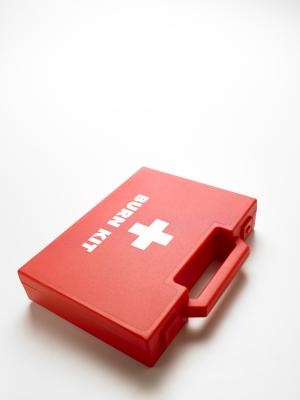
Drivers who spend increasing amounts of times on the roads should carry an emergency roadside kit for unexpected events. When your car breaks down unexpectedly or some other emergency befalls you, a properly equipped emergency kit can help get you back on the road or perhaps save your life. Properly maintain your kit, because you never know when you will need it; when you do need it, you will be glad that it is there and in good condition. A checklist helps you to inventory and maintain the essential components of a good roadside emergency kit.
Cell phone coverage is available almost everywhere. Keeping a phone in the car can be the quickest, surest way to safety. If you do not have a cell phone for everyday use, consider purchasing a prepaid phone to keep in the car for emergencies. You can also join an auto club, such as AAA, which provides emergency roadside assistance with just a phone call. Give your car's cell number to family and friends; let them know your destination on an extended trip, when you expect to return and your planned route. Some vehicles are equipped with CB radios; learn how to use this equipment to call for help in an emergency.
Basic tools from your car's emergency kit can help fix minor mechanical issues and get you back on the road. Jumper cables allow another vehicle to jumpstart your dead battery. Always carry a car jack and tire iron to remove and replace flat tires. Keep one flathead and one Phillips-head screwdriver for removing small parts. Consider purchasing a portable air pump that runs off DC power to inflate leaky tires; also keep a tire gauge to check air pressure in tires.

Emergencies can happen at any time of the day or night. Prepare for nighttime problems by packing lighting equipment. Pack a flashlight and check the batteries on a regular schedule to ensure proper working operation. Chemical glow sticks, available at most home-improvement stores, provide soft light for up to 12 hours each. Keyring microlights are a good backup and are always available on the road. Pack reflective triangles, to be placed around your stopped vehicle, to alert other drivers to your position. Reflective "Help" signs are a good way to signal that you need assistance; road flares perform the same function and are visible at night.

Because of always-variable weather conditions, include seasonal clothing in your car's emergency kit. When choosing clothing, consider the types of weather and the time of year in your travel area. If you live in places prone to rain, pack a lightweight poncho. For hot climates, pack a hat to keep the sun off your face and neck. For cold climates, pack an extra jacket or a blanket that you can use to stay warm while awaiting help. If you travel with children, pack extra layers of clothing just for them.
The Federal Emergency Management Agency recommends that all vehicle emergency kits contain food and water. Pack several plastic 8-oz. water bottles. Do not use cardboard or glass materials for water storage. Include dry, nonperishable foods that are temperature-stable and will store well for several months, such as individually wrapped energy bars or vacuum-packed crackers. Avoid foods with high salt content, which can make you thirsty. For children, pack cookies or cheese crackers. Having a small amount of food and water on hand can support your body's energy needs during high-stress emergency situations. To treat minor medical issues from the roadside, include a small first-aid packet that include bandages, aspirin, rubbing alcohol and any prescription medication you may need. Frequently check expiration dates on any type of medical supply in your roadside emergency kit.
